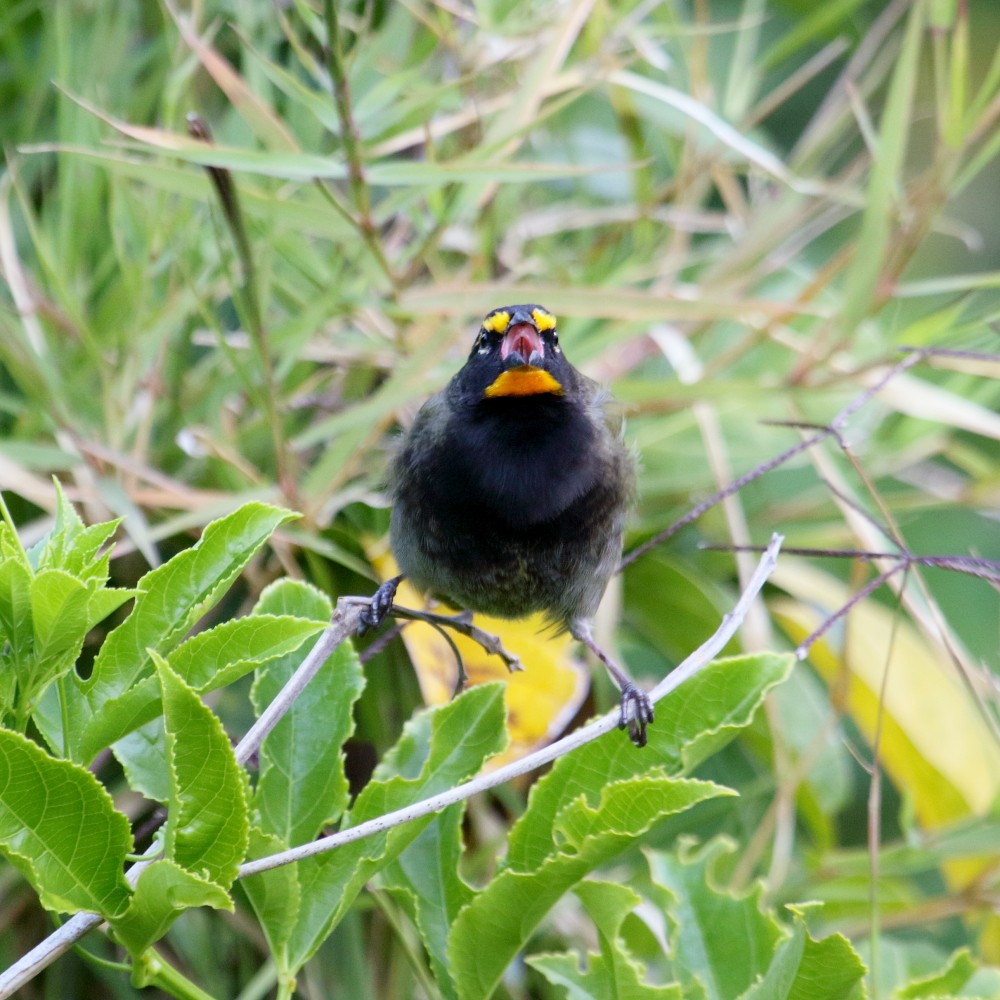Yellow-faced Grassquit
A species of Grassquits Scientific name : Tiaris olivaceus Genus : Grassquits
Yellow-faced Grassquit, A species of Grassquits
Botanical name: Tiaris olivaceus
Genus: Grassquits
Content
Description General Info
 Photo By Cephas , used under CC-BY-SA-4.0 /Cropped and compressed from original
Photo By Cephas , used under CC-BY-SA-4.0 /Cropped and compressed from original Description
It is a small bird with a conical bill, sharper than that of the related seedeaters. It is 10–10.7 cm (3.9–4.2 in) long and weighs about 8–10 g (0.28–0.35 oz), depending on subspecies. The adult male has an olive-green back, and its face and breast are black apart from a bright yellow throat, supercilia, and lower eyelid spot. The rest of the underparts are greyish olive. The beak and eyes are dark, the legs are grey. The adult female is slightly smaller on average than the male. It is dull olive-green above and paler grey below, and may have some dark breast smudges. The yellow face pattern is much weaker and duller, and may be almost invisible. The lower part of the beak is dark horn-colored (light grey). Young birds are coloured essentially like the adult female, but duller and greyer. Young males begin to acquire full adult plumage in their first year. The yellow-faced grassquit has a weak buzzing trilled ttttt-tee call. The song is a varying series of high thin rapid trills. Given for a prolonged time, it is melodious, yet subdued, and often only heard from a short distance away. 
Size
10-11 cm (4-4.5 in)
Nest Placement
Shrub
Feeding Habits
Yellow-faced Grassquit primarily consumes seeds and grasses, supplemented with insects and berries. It forages at ground level, typically displaying a preference for open grassy areas where it pecks and searches for food, showcasing an adaptation for seed-based diets.
Habitat
Yellow-faced Grassquit thrives in a variety of predominantly humid to semi-arid open habitats found across broader tropical and subtropical regions. Commonly, yellow-faced Grassquit can be observed in secondary growth areas, edges of forests, and overgrown herbaceous environments like weedy fields and hedgerows. These birds are also prevalent in man-made landscapes such as pastures, gardens, and along the peripheries of fields and roadsides. Dense thickets and neglected lawns also comprise part of their preferred habitats.
Dite type
Granivorous
General Info
Feeding Habits
Bird food type
Distribution Area
It breeds from central Mexico to northern Ecuador and north-western Venezuela, and also on the Greater Antilles and nearby islands (e.g. the Cayman Islands). It is not a migratory bird but moves about outside the breeding season; vagrants have been recorded in Southern Texas and Florida. It has been introduced to Hawaii. The yellow-faced grassquit is a common to abundant resident in lowlands and foothills up to 2,300 m (7,500 ft) altitude in semi-open areas such as roadsides, pasture, weedy fields and low scrub. It avoids dry grassland and other very low growth, but will readily utilize neglected gardens where lawn grass has grown high. It is a fairly sociable bird, sometimes forming loose flocks with other tanagers (such as seedeaters) and emberizids that share its lifestyle. Occasionally, adult males will come together to perch in a shrub and sing. This species feeds mainly on grass seeds, but also takes other seeds, berries and some insects. Food is typically plucked from the inflorescences directly, or gathered from the ground. Animal prey is hunted among foliage in a New World warbler-like fashion. The main breeding season is in the summer months, but except for February to April birds may nest at other times of the year. This species sometimes forms loose nesting colonies. During courtship, the male vibrates his wings as he sings his subdued song, sitting only 1–2 in (2.5–5.1 cm) away so the female can properly hear him. The roughly globular nest, built by the female, is made of grass and weed stems compacted into a thick mass, and lined with pieces of grass inflorescences and bast fibre. It has a side entrance and is placed usually less than 30 cm (12 in) above the ground, often among grass or weeds on a road or river embankment. Occasionally, the species nests in shrubs up to 1.5 m (4.9 ft) above the ground. The clutch is two or three, rarely four, brown-speckled white eggs. They are incubated by the female alone for 12–14 days to hatching. This bird is not rare and widely distributed; it is thus classified a species of least concern by the IUCN. It seems to benefit from deforestation, increasing in numbers and expanding its range; for example, it is only since 1997 known from the eastern Andean slope of Meta Department in Colombia. 
Species Status
Not globally threatened.
Scientific Classification
Phylum
Chordates Class
Birds Order
Perching birds Family
Tanagers Genus
Grassquits Species
Yellow-faced Grassquit